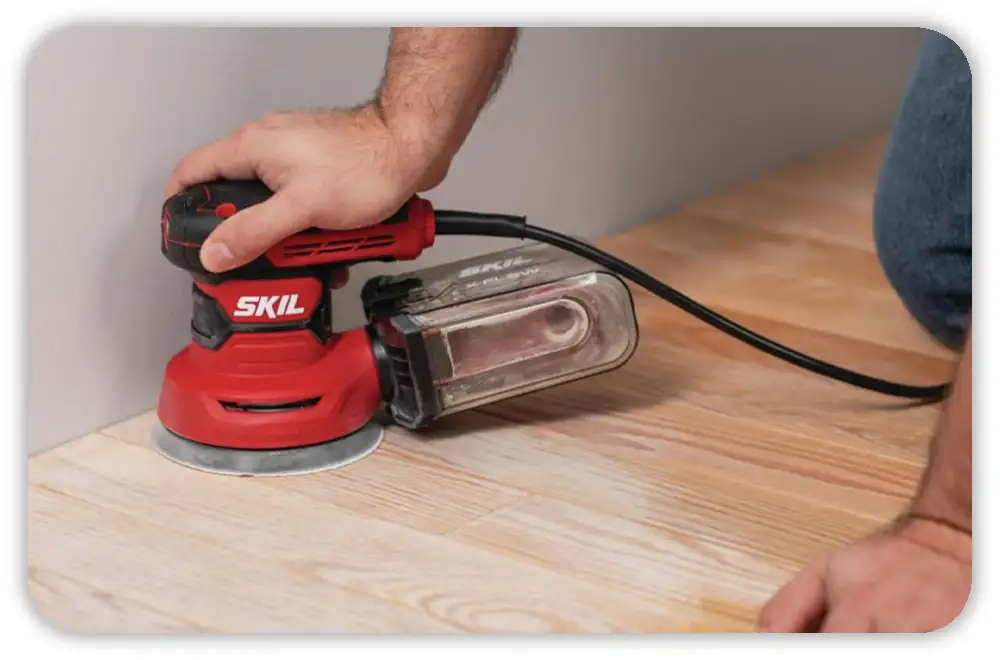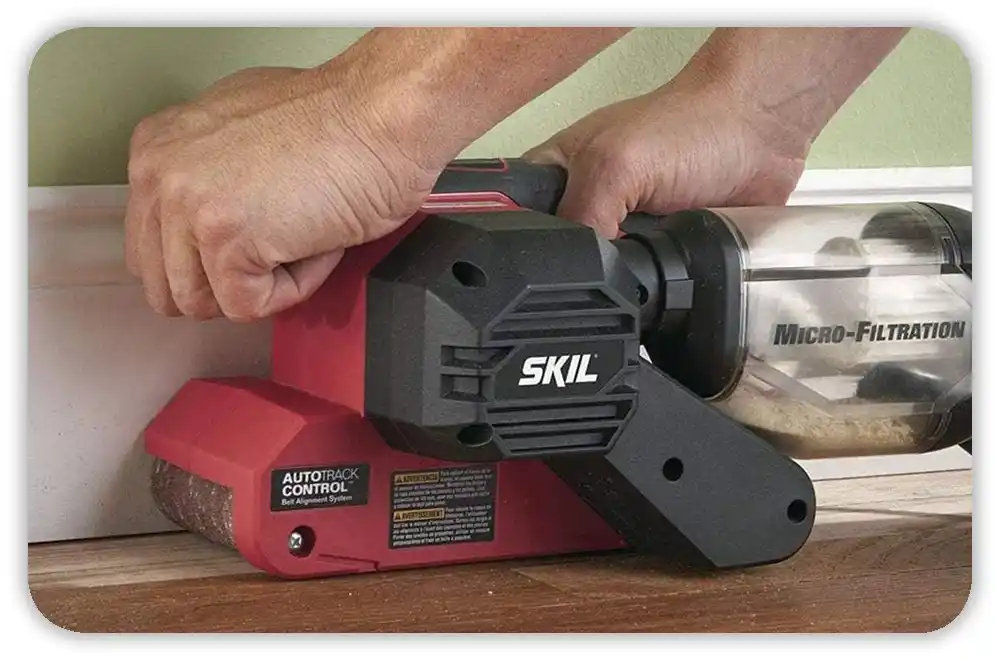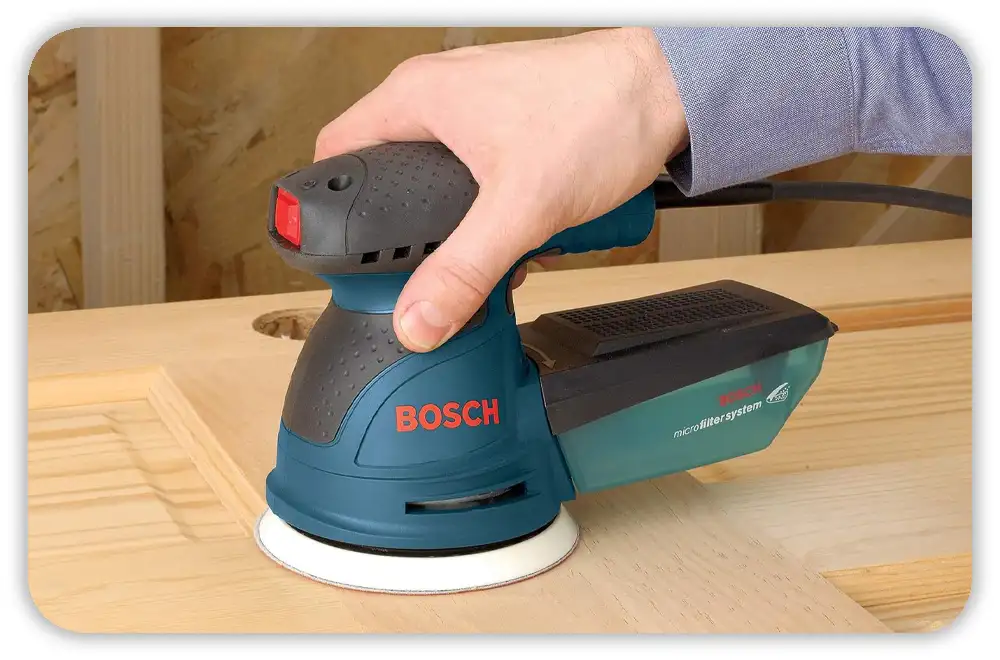I’ve asked myself this same question many times while working in my shop. The truth is, the answer depends on the job. A belt sander cuts fast and removes a lot of wood in a short time. An orbital sander works slower but leaves the surface smooth and ready for finish. In most projects, I’ve found they’re best used together, one after the other.
Table of Contents
Quick Answer — Which One Is Better?
People often ask me which sander is better. My answer is simple.
If I need to remove a lot of wood fast, I use the belt sander. It has the power to level boards, strip paint, and fix rough spots. It’s great when I need to change the shape of the wood. The key idea is that a belt sander is for heavy wood removal.
When I want the wood to look smooth, I grab the random orbital sander. It works slower but gives a clean, even surface. It does not leave long scratch lines, so the finish looks better on walnut, oak, or maple. The orbital sander is best for finish sanding and prep work.
In my shop, I often use both tools. The belt sander does the rough work. The orbital sander makes the surface ready for finish. Together, they give the best results. The truth is, neither tool replaces the other — they work as a team.
What’s the Real Difference Between a Belt Sander and an Orbital Sander?

Belt Sander — High Removal, Straight Motion
A belt sander uses a sanding belt that runs over two drums. The belt moves in one direction. This straight motion lets it remove wood very fast. I use it for floors, large tabletops, and old boards that need deep cleaning.
But it takes care. The belt sander can dig into the wood if I press too hard or stay in one spot. When I first learned, I left deep marks because I forced the tool. I later learned that it’s better to let the weight of the sander do the work.
I use 50–120 grit belts. Lower grits for stripping, higher ones for smoothing before switching to the orbital. The main idea is that the belt sander removes wood fast but is not for final finishing.
Random Orbital Sander — Smooth Finish, No Swirls
The random orbital sander moves in a small, round, random pattern. Because of this, it doesn’t leave long scratches. It’s my top choice for smooth, swirl-free sanding.
When I sand a tabletop for stain or clear coat, I use the orbital. It gives a clean, even finish. It also works well on curved edges because the pad can float over the shape.
I use 120–220 grit discs for most jobs. With slow, steady passes, it gives a pro-level surface. The key idea is that the orbital sander refines the surface, not removes bulk wood.
How Does Material Removal Rate Compare?
When I need to level or reshape wood, the belt sander always wins. It removes material fast. I’ve used it on rough boards from a sawmill, and it smoothed them in minutes. The belt sander is made for shaping and heavy removal.

The orbital sander works slower and more gently. If I tried to flatten a twisted board with it, I’d waste hours. But when I prep cabinet doors for paint, it’s perfect. It scuffs the surface just enough for primer to stick, without damage.
| Feature | Belt Sander | Orbital Sander |
| Material Removal | High | Low to Medium |
| Best For | Leveling & Shaping | Final Finishing |
| Speed Metric | Feet per minute (FPM) | Orbits per minute (OPM) |
Which Sander Gives a Better Finish?
When I want a clean, smooth surface, the random orbital sander almost always wins. The belt sander moves in one straight direction, so it leaves long scratch lines. Even when I’m careful, those lines still show in bright light, especially on oak or cherry. Because of that, I now use the belt sander only for shaping and leveling. The key point is that the belt sander is not a finishing tool.
The orbital sander moves in a random pattern. The scratches it makes are tiny and spread out. These marks vanish under stain or clear coat, leaving the wood clean and even. This matters most when I want the natural wood grain to show, like on walnut or maple. The main idea is that the orbital sander creates a surface ready for finish.
When You Want a Flawless Finish
When I want a smooth, swirl-free finish, I follow a simple grit order:
- 120 grit
- 150 grit
- 180 grit
- Optional 220 grit for the final pass
I keep my pressure light and let the sander’s weight do the work. Pressing too hard can cause uneven spots. Slow, steady passes give the best results. The key takeaway is that patience and light pressure make a better finish than force.
Skill Level — Which Sander Is Easier to Use?

In my experience, the orbital sander is easier for beginners. It’s light, simple, and forgiving. I can guide it with one hand, move at a relaxed pace, and still get a clean result. Even if the pressure isn’t perfect, it won’t dig into the wood. That’s why I suggest the orbital sander as a first tool for new woodworkers.
The belt sander takes more skill. When I first used one, I made dents because I pushed too hard. Its strong motor can dig in fast if my wrist tilts even a little. Over time, I learned to move gently and let the motor work on its own. The main point is that the belt sander needs practice, while the orbital sander is easy to learn.
Real Workshop Scenarios (U.S. Context)
H3: Refinishing a Hardwood Floor
When I refinished a hardwood floor, the belt sander was the hero. The old finish was thick and hard to remove. The belt sander stripped it fast and leveled the dents. Then I used the orbital sander to smooth the wood before sealing. The key point is that large, flat surfaces with heavy finish build-up need the belt sander first.
Building a Walnut Coffee Table
When I built a walnut coffee table, I used both sanders. The belt sander flattened the glue joints between boards. Then the orbital sander smoothed the top and brought out the walnut grain before I oiled it. The lesson here is that using both tools together gives faster and better results.
Repainting Kitchen Cabinets
When I prepped old kitchen cabinets for paint, the orbital sander was perfect. I only needed to scuff the surface so the primer could stick. It did the job without digging in, and it made less dust — great for indoor work. The key idea is that for light prep jobs, the orbital sander is easier and cleaner.
Stripping Thick Exterior Paint
When I stripped thick paint from old deck boards, the belt sander worked best. The heat and friction helped break down the paint fast. It saved me hours of scraping. For outdoor jobs with tough, layered finishes, I always start with the belt sander. The key point is that heavy-duty outdoor sanding is where the belt sander shines.
Brands and Buying Guide (U.S. Market)
Over the years, I’ve tried many sanders from different brands. Some worked great. Others didn’t last. I don’t buy tools based on ads. I buy them based on how they feel in my hands and how they hold up under real work. Here are the belt and orbital sanders I’ve had the best luck with in my shop.
Common Belt Sanders
DeWalt: DeWalt belt sanders run steady and stay balanced. I like that the belt tracks straight without much adjustment. It feels smooth and easy to control. For me, it’s a reliable choice for daily work. The key point is that DeWalt runs smooth and stays predictable.
Makita: Makita belt sanders are strong and built for heavy sanding. When I need to flatten rough boards or strip thick paint, Makita has the power to do it fast. It’s a little louder, but the strength makes up for it. The main idea is that Makita handles tough jobs well.
Ridgid: Ridgid is a solid pick if you want a tough tool at a fair price. I’ve used Ridgid sanders for decks and general shop work, and they’ve held up fine. It’s a smart fit for DIYers who want durability without a big cost. The key point is that Ridgid offers great value.
Common Random Orbital Sanders
Milwaukee: Milwaukee orbital sanders have strong dust collection. That matters when I’m sanding indoors during winter. They keep the air cleaner and save cleanup time. The key point is that Milwaukee works great for indoor sanding.
Bosch: Bosch sanders feel smooth and easy to handle. They vibrate less, so I can sand longer without hand fatigue. That helps when I’m finishing large tabletops. The main idea is that Bosch is comfortable for long sanding sessions.
Ryobi: Ryobi is a budget-friendly option. I use it for light work like sanding trim or cabinet doors. It’s not the strongest, but it’s fine for small jobs. The key takeaway is that Ryobi is a good starter tool for casual use.
Safety and Dust Collection
Sanding makes dust fast. I learned early that ignoring dust makes a mess and hurts air quality. Belt sanders create more dust because they remove more wood. I always connect a shop vac when I use one. It keeps the air clear and helps me see the surface better.
Orbital sanders usually have built-in dust collection. The holes in the pad pull dust into a bag or vacuum. This setup is cleaner and safer for indoor work, especially in a closed garage.
No matter the tool, I always wear a dust mask or N95. Even light sanding sends fine dust into the air. The key point is to protect your lungs and keep your workspace safe.
So, Is a Belt Sander Better Than an Orbital Sander?
If I want fast removal, the belt sander is better. If I want a smooth finish, the orbital sander is better.
The best results come from using both in order:
Belt → Orbital → Finish
- The belt sander shapes the wood.
- The orbital sander refines the surface.
This simple order keeps the workflow smooth and helps avoid mistakes. The rule I always share is:
Use a belt sander to remove. Use an orbital sander to refine.
That rule has given me the most consistent results over the years.
FAQs: Is a Belt Sander Better Than an Orbital Sander
Can I use an orbital sander instead of a belt sander?
Yes, you can — but it depends on the job. I’ve tried using an orbital sander to level boards or strip thick finish, and it took a long time. The orbital sander works slow and gentle. It’s great for smoothing, but not for shaping. The key point is that the orbital sander can replace the belt sander only for light sanding jobs.
Can a belt sander do finish sanding?
I don’t recommend it. The belt sander moves in one straight direction, so it leaves long scratches that show under stain or clear coat. I made that mistake once and had to redo the surface with the orbital sander. The belt sander is powerful, but finishing needs a gentle touch. The main idea is that the belt sander is for removal, not for final prep.
Which should I buy first?
If you’re buying just one sander, start with a random orbital sander. It’s easy to handle, safe for beginners, and fits most home projects — like furniture repair, cabinet prep, or smoothing edges. I use my orbital sander far more often than my belt sander. The key takeaway is that the orbital sander is the most versatile first tool.
Final Takeaway
A belt sander is not better than an orbital sander — each one has its job. The belt sander removes wood fast and shapes the surface. The orbital sander smooths the wood and gets it ready for stain or finish. I’ve learned that the best results come from using both in sequence:
Belt → Orbital → Finish
This simple process gives clean surfaces, steady results, and less stress. The main idea is to match the tool to the task, not to pick one tool over the other.

